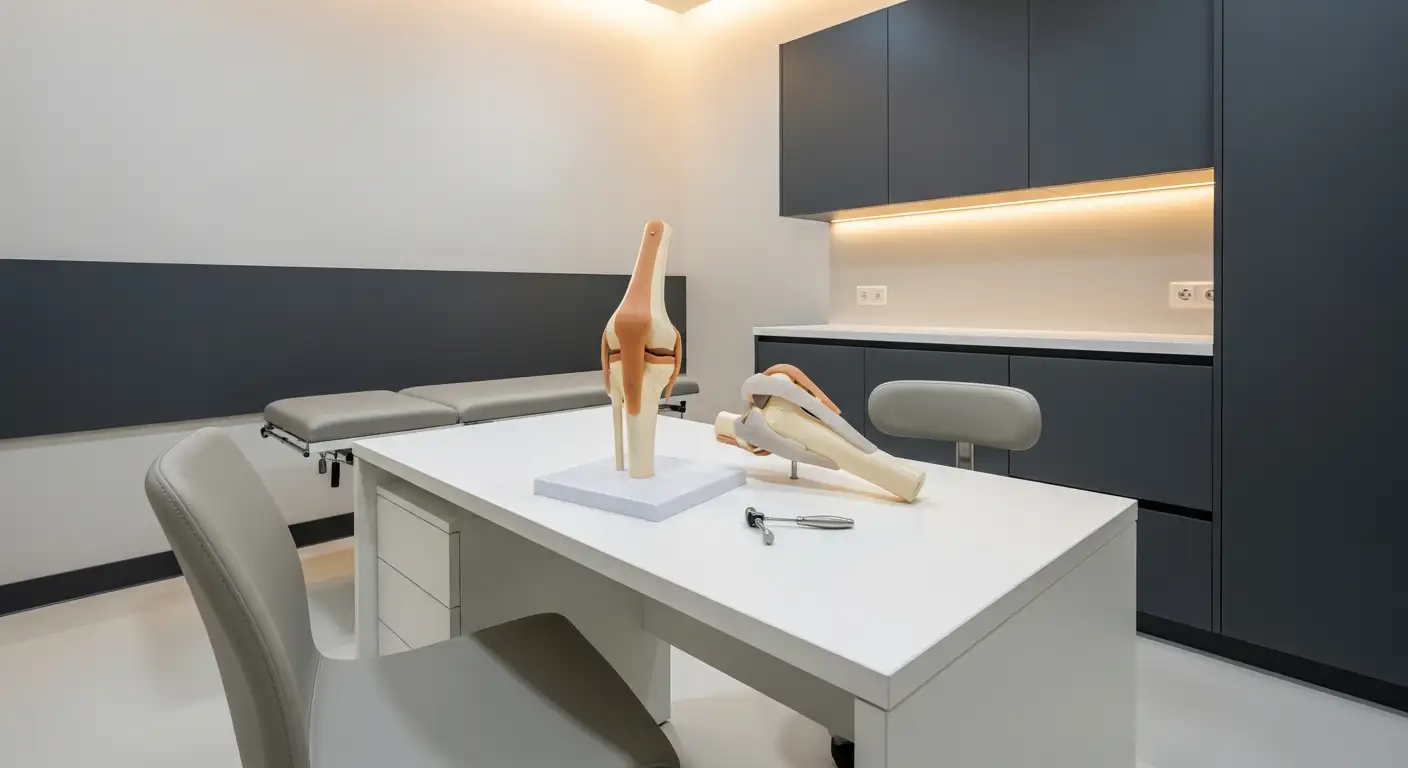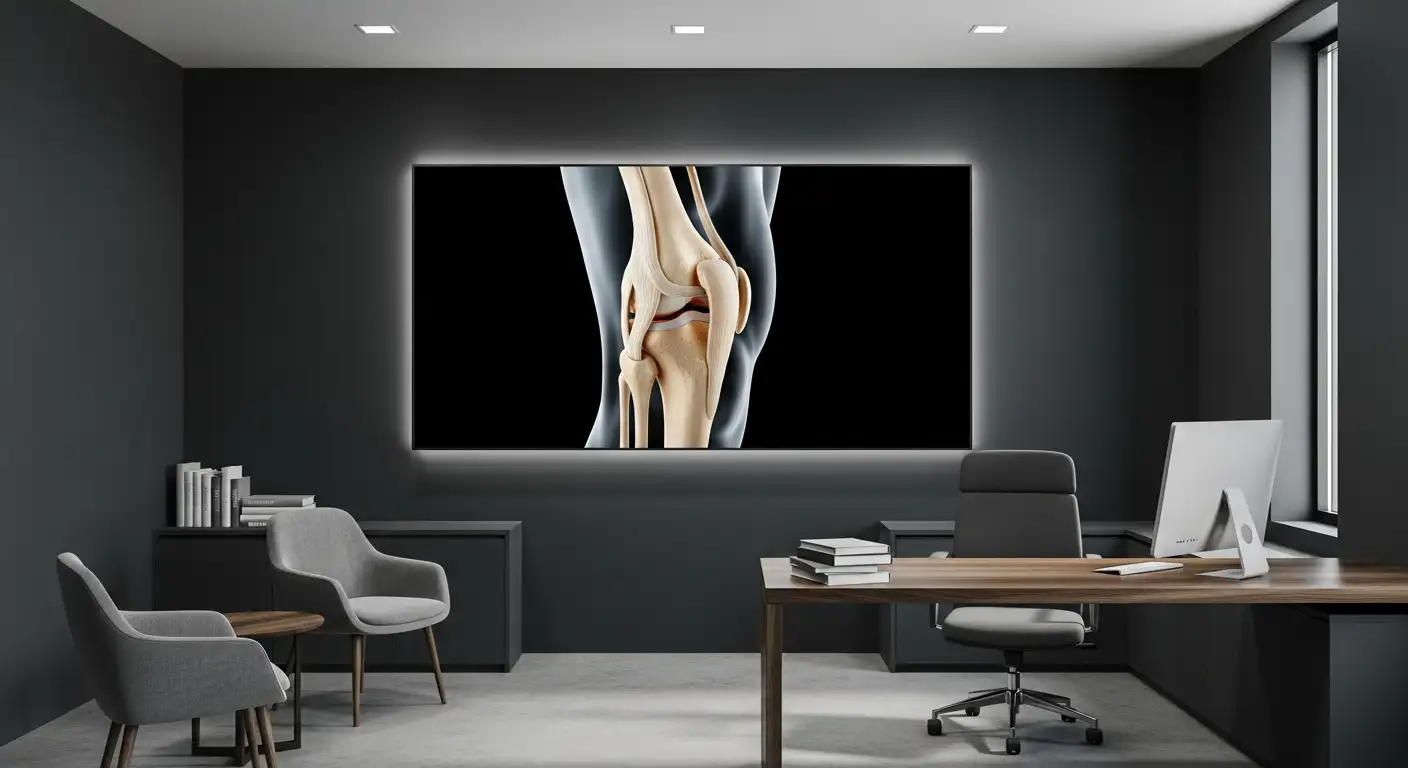Understanding Knee Pain
Experiencing a sharp pain when lifting the knee can be alarming and may significantly interfere with daily activities. Understanding the potential causes and contributing factors to this type of knee pain is crucial in addressing the issue effectively.
The Anatomy of the Knee
The knee is a complex joint that connects the thigh bone (femur) to the shinbone (tibia). It also includes the kneecap (patella), which sits at the front of the knee. The knee joint is cushioned by two C-shaped pieces of cartilage known as the menisci, which help distribute weight across the joint. In addition, there are four main ligaments in the knee that help stabilize the joint. These include the anterior cruciate ligament (ACL), posterior cruciate ligament (PCL), medial collateral ligament (MCL), and lateral collateral ligament (LCL).

Common Causes of Knee Pain
A sharp, anterior knee pain, particularly prominent when lifting the heel of the affected side while keeping the knee extended, may be indicative of patellar tendinopathy, also known as "jumper's knee".
Another possible cause of sharp pain when lifting the knee is a meniscus tear. This occurs when the cartilage in the knee tears, usually as a result of twisting the knee while bearing weight. Such tears can cause pain, swelling, and stiffness in the knee.
ACL injuries can also cause sharp pain when lifting the knee. These injuries are common in activities like skiing, football, soccer, and basketball, where sudden stops or changes in direction can stress the knee.
Patellofemoral pain syndrome (PFPS) could also lead to sharp pain when lifting the knee. This syndrome causes pain at the front of the knee and is common in activities like running, cycling, and weightlifting [2].
Lastly, if lifting the knee causes sharp pain, it could be a sign of hip flexor strain or tightness. Hip flexor issues can also cause difficulty walking or climbing stairs [2].
In summary, there are various potential causes of sharp knee pain when lifting the knee. Accurate diagnosis is essential to ensure that the most effective treatment is provided. If you experience persistent or severe knee pain, consult a healthcare professional for a thorough evaluation.
Identifying Sharp Pain When Lifting Knee
When experiencing a sharp pain while lifting the knee, it's crucial to identify the potential causes to guide treatment. Three common conditions associated with sharp knee pain when lifting include patellar tendinopathy, meniscus tear, and ACL injuries.
Indicators of Patellar Tendinopathy
Patellar tendinopathy, also known as "jumper's knee," is characterized by a sharp, anterior knee pain. This pain is particularly noticeable when an individual is lifting the heel of the affected side while keeping the knee extended [1]. Other symptoms can include tenderness at the base of the kneecap, swelling, and a decrease in the knee's range of motion.
Signs of a Meniscus Tear
Meniscus tears typically occur from twisting movements when the knee bears weight. If you're experiencing sharp pain when lifting the knee, a meniscus tear could be the cause. Additional signs of this injury include pain, swelling, stiffness, and sometimes a locking sensation in the knee [2].
Symptoms of ACL Injuries
The Anterior Cruciate Ligament (ACL) is a key stabilizer in the knee, and injuries to this ligament can cause sharp pain when lifting the knee. ACL injuries are common in sports that require sudden stops or changes in direction, like skiing, football, soccer, and basketball [2]. An ACL injury is often accompanied by a popping sound at the time of injury, immediately followed by swelling, instability, and pain when bearing weight.
When dealing with sharp knee pain, early identification of the cause is critical for effective treatment. It is recommended that an individual experiencing sharp pain when lifting the knee seek medical consultation for a thorough evaluation and appropriate treatment.
Other Factors Influencing Knee Pain
While conditions directly related to the knee are often the culprits behind sharp pain when lifting the knee, other factors involving the surrounding musculature can also contribute. This section will explore how issues such as hip flexor strain, Patellofemoral Pain Syndrome (PFPS), and Iliotibial Band Syndrome can influence knee pain.
Hip Flexor Strain and Knee Pain
Sharp pain when lifting the knee could be a sign of hip flexor strain or tightness. The hip flexors are a group of muscles near the top of your thighs that are key in lifting the knee and moving the leg towards your body. When these muscles are strained or tight, it can lead to pain in the knee, especially when lifting it. Hip flexor issues can also cause difficulty walking or climbing stairs [2].
Engaging in exercises to strengthen the muscles around the knee and hip can help reduce the risk of hip flexor strain and alleviate pain associated with this condition.
Patellofemoral Pain Syndrome and Knee Pain
Another factor that could lead to sharp pain when lifting the knee is Patellofemoral Pain Syndrome (PFPS). This syndrome causes pain at the front of the knee, particularly during activities that involve bending the knee, such as running, cycling, and weightlifting. The pain is a result of the stress placed on the point where the kneecap (or patella) rests on the thighbone (or femur).
As with hip flexor strain, exercises to strengthen the muscles around the knee can help reduce the risk of PFPS and alleviate pain associated with this syndrome.
Iliotibial Band Syndrome and Knee Pain
A common cause of sharp pain when lifting the knee is Iliotibial Band Syndrome. The iliotibial band is a piece of connective tissue that runs along the outside of the thigh from the hip to the shinbone. When it becomes tight or inflamed, it can cause pain, often felt on the outside of the knee. This is particularly common in runners, cyclists, and other athletes who repeatedly flex and extend the knee [3].
Again, strengthening exercises targeting the muscles around the knee, as well as stretching exercises for the iliotibial band itself, can help manage and prevent this condition.
In conclusion, while knee-related conditions are often responsible for sharp pain when lifting the knee, issues involving the hip flexors, PFPS, and the Iliotibial Band can also contribute to this discomfort. By understanding these potential causes, individuals can take steps towards proper treatment and preventive strategies.
Diagnosing Knee Pain
When experiencing a sharp pain when lifting the knee, it's important to accurately diagnose the cause in order to receive the most effective treatment. The process of diagnosing knee pain typically involves a consultation and physical examination, followed by diagnostic imaging techniques if needed.
Consultation and Physical Examination
The first step in diagnosing knee pain is a comprehensive consultation with a healthcare provider, usually a doctor. During the consultation, the doctor will typically ask about the type of pain, how it began, and any associated symptoms. This information can help determine the underlying cause of the knee pain [4].
Furthermore, the doctor will perform a physical examination of the knee to assess its condition. This may involve checking for swelling, tenderness, and the range of motion of the knee. The doctor may also ask the patient to walk, squat, or perform other movements to evaluate the knee's function and stability.
It's advisable to consult a doctor if the sharp pain in the knee persists for more than a few days. Early diagnosis and treatment can help prevent further injury or complications.
Diagnostic Imaging Techniques
If the cause of the knee pain is still unclear after the consultation and physical examination, the doctor may recommend diagnostic imaging tests. These tests can provide a detailed view of the knee joint and surrounding tissues, helping to identify any abnormalities or injuries.
Various imaging tests can be used to evaluate the condition of the knee joint, including X-rays, MRIs, CT scans, arthroscopy, and radionuclide bone scans.
Understanding the severity of knee pain, based on scales like the WOMAC pain subscale, can also be essential in diagnosing knee injuries among individuals with, or at risk for, knee osteoarthritis.
In conclusion, diagnosing knee pain is a multistep process that begins with a thorough consultation and physical examination, followed by diagnostic imaging techniques if necessary. By accurately diagnosing the cause of knee pain, appropriate and effective treatment can be implemented to relieve pain and improve knee function.
Treatment Options for Knee Pain
When it comes to treating sharp pain when lifting the knee, there are a variety of options available. The chosen treatment will largely depend on the severity of the injury and the underlying cause of the pain. These treatment options can range from non-invasive methods, such as rest and physical therapy, to surgical interventions in more severe cases.
Non-Invasive Treatments
Non-invasive treatment methods are often the first line of defense for knee pain. These treatments aim to decrease inflammation, alleviate pain, and restore function to the knee without having to resort to surgery. It's important to note that the effectiveness of these treatments may vary depending on the individual and the severity of the knee injury.
Non-invasive treatments for knee pain include:
- Rest and Ice: Resting the knee allows it to heal, while applying ice can help reduce inflammation and numb the area to relieve pain.
- Physical Therapy and Exercise: A targeted exercise regimen tailored to the individual's condition can aid in the healing process and strengthen the knee to prevent future injuries.
- Medication: Over-the-counter pain relievers and anti-inflammatory medications can help manage pain and swelling.
If non-invasive treatments do not provide relief and X-rays show joint destruction, more invasive treatments may be necessary.
Surgical Interventions
In more severe cases, when non-invasive treatments have proven ineffective, surgical interventions may be recommended. The type of surgery performed will depend on the specific cause and severity of the knee pain.
Surgical interventions include:
- Arthroscopy: This minimally invasive procedure involves inserting a small camera into the knee joint to inspect and repair the damaged area.
- Partial Knee Replacement: In this procedure, only the damaged part of the knee is replaced with an artificial joint.
- Total Knee Replacement: This procedure, also known as knee arthroplasty, involves replacing the entire knee joint with an artificial one. It may be recommended by an orthopedist if initial treatments for knee problems do not provide relief and X-rays show joint destruction [5].
It's crucial to remember that the recovery process after surgery can be lengthy and requires commitment to physical therapy and rehabilitation exercises to regain strength and mobility in the knee.
The severity of knee pain and the individual's history of knee injuries are important factors to consider when determining the most appropriate treatment for knee pain. Consulting with a healthcare professional will ensure that the chosen treatment is suitable and safe for the individual's specific condition.
Preventive Measures and Exercises
Relief from sharp pain when lifting the knee isn't solely dependent on medical treatments. There are a variety of preventive measures and exercises that can be beneficial for reducing knee pain and preventing future injuries.
Importance of Strengthening Exercises
Engaging in exercises to strengthen the muscles around the knee can help reduce the risk of injury and alleviate pain associated with conditions like meniscus tears, ACL injuries, and Patellofemoral Pain Syndrome (PFPS). Regular exercise can improve the stability of the knee joint and promote healthy knee function. However, it is advised to commence exercising practices carefully, avoiding any that lead to increased pain. Individuals should steer clear of workouts that exert stress on a debilitated or wounded limb or back area [8].
Recommended Exercises for Knee Pain
Certain exercises are particularly beneficial for strengthening the knee and relieving knee pain. These exercises also enhance flexibility, which is crucial for maintaining healthy joint function and preventing injury.
Treatment for Patellofemoral Pain Syndrome often involves strengthening and stretching exercises for the legs, hips, and core muscles. Physical therapy may be recommended to create an exercise plan incorporating activities like stretching, squats, planks, and lunges to enhance strength and flexibility.
One specific exercise aimed at knee strengthening and flexibility is the "Straight-Leg Lift Exercise." Here's how to perform this exercise:
- Lie on your back.
- Bend one leg at the knee, keeping your foot flat on the floor.
- Extend the other leg straight out.
- Slowly raise the straight leg to a forty-five-degree angle.
- Hold this position for a few seconds.
- Slowly lower your leg back to the floor.
- Repeat this movement twenty times for each leg.
This exercise is designed to strengthen the quadriceps, the large muscle group at the front of the thigh. By strengthening these muscles, you can provide better support for your knees and reduce the risk of injury.
Remember, everyone's body is different, and what works for one person may not work for another. Therefore, it's essential to consult with a physical therapist or other healthcare professional before starting a new exercise regimen to ensure that the exercises are safe and effective for your specific needs and condition.
References
[2]: https://www.healthline.com/health/exercises-for-knee-pain
[3]: https://www.mayoclinic.org/diseases-conditions/knee-pain/symptoms-causes/syc-20350849
[4]: https://www.medicalnewstoday.com/articles/310653
[5]: https://www.hopkinsmedicine.org/health/conditions-and-diseases/knee-pain-and-problems
[6]: https://www.ncbi.nlm.nih.gov/pmc/articles/PMC4522334/
[7]: https://kidshealth.org/en/teens/runners-knee.html
[8]: https://thcboneandjoint.com/educational-resources/knee-exercises.html





